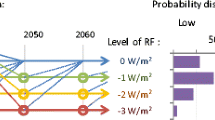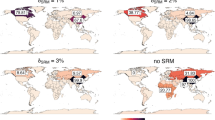Abstract
Solar geoengineering (SGE) constitutes a viable option to ameliorate anthropogenic temperature rise. However, it does not simultaneously compensate for anthropogenic changes in further climate variables in a perfect manner. Here, we investigate to what extent a proponent of the 2 °C-temperature target would apply SGE in conjunction with mitigation in view of regional disparities in temperature and precipitation. We apply cost-risk analysis (CRA), which is a decision analytic framework that trades-off expected welfare-loss from climate policy costs and climate risks from transgressing a climate target. Here, in ‘Giorgi’-regional-scale analyses, we evaluate the optimal mix of SGE and mitigation under probabilistic information about climate sensitivity and generalize CRA in order to include regional temperature and precipitation risks. In addition to a mitigation-only analysis, social welfare is maximized for the following three joint-mitigation-SGE scenarios: temperature-risk-only, precipitation-risk-only, and equally weighted both-risks. We find that for regionally differentiated precipitation targets, the usage of SGE will be restricted. Our results indicate that SGE would save 70–75% of welfare-loss in the precipitation-risk-only and both-risks scenarios compared to a purely mitigation-based analysis with approximate overall welfare loss of 4% in terms of balanced growth equivalent from economic costs and climate risks.







Similar content being viewed by others
Notes
Available at https://esgf-data.dkrz.de/search/esgf-dkrz/.
Welfare equation in this case is: \( W = \mathop \sum \nolimits_{t} \mathop \sum \nolimits_{s} p_{s} \left[ {U\left( {t,s} \right) - \beta R\left( {T\left( {t,s} \right)} \right) - \mathop \sum \nolimits_{r} \alpha_{r} R\left( {P\left( {t,s,r} \right)} \right)} \right]e^{ - \rho t} \).
According to the guidance note of IPCC on uncertainty.
Consumption-loss compared to BAU consumption.
Abbreviations
- AMZ:
-
Amazonia
- BAU:
-
Business-as-usual
- BGE:
-
Balanced growth equivalent
- CBA:
-
Cost–benefit analysis
- CEA:
-
Cost effectiveness analysis
- CNA:
-
Central North-America
- CRA:
-
Cost-risk analysis
- EPR:
-
Expected regional precipitation risk
- ETR:
-
Expected regional temperature risk
- GHG:
-
Greenhouse gas
- SAH:
-
Sahara
- SGE:
-
Solar geoengineering
- SQF:
-
South Equatorial Africa
- WNA:
-
West North-America
References
Arino Y, Akimoto K, Sano F, Homma T, Oda J, Tomoda T (2016) Estimating option values of solar radiation management assuming that climate sensitivity is uncertain. Proc Natl Acad Sci 113:5886–5891. https://doi.org/10.1073/pnas.1520795113
Bahn O, Chesney M, Gheyssens J, Knutti R, Pana AC (2015) Is there room for geoengineering in the optimal climate policy mix? Environ Sci Policy 48:67–76. https://doi.org/10.1016/j.envsci.2014.12.014
Bala G, Duffy PB, Taylor KE (2008) Impact of geoengineering schemes on the global hydrological cycle. Proc Natl Acad Sci 105:7664–7669. https://doi.org/10.1073/pnas.0711648105
Barrett S et al (2014) Climate engineering reconsidered Nature. Clim Change 4:527–529. https://doi.org/10.1038/nclimate2278
Crutzen PJ (2006) Albedo enhancement by stratospheric sulfur injections: a contribution to resolve a policy dilemma? Clim Change 77:211. https://doi.org/10.1007/s10584-006-9101-y
Doney SC, Fabry VJ, Feely RA, Kleypas JA (2009) Ocean acidification: the Other CO2 problem. Annu Rev Mar Sci 1:169–192. https://doi.org/10.1146/annurev.marine.010908.163834
Edenhofer O, Bauer N, Kriegler E (2005) The impact of technological change on climate protection and welfare: insights from the model MIND. Ecol Econ 54:277–292. https://doi.org/10.1016/j.ecolecon.2004.12.030
Ekholm T, Korhonen H (2016) Climate change mitigation strategy under an uncertain solar radiation management possibility. Clim Change 139:503–515. https://doi.org/10.1007/s10584-016-1828-5
Emmerling J, Tavoni M (2017) Climate engineering and abatement: a ‘flat’ relationship under uncertainty environmental and resource economics. https://doi.org/10.1007/s10640-016-0104-5
Frieler K, Meinshausen M, Mengel M, Braun N, Hare W (2012) A scaling approach to probabilistic assessment of regional climate change. J Clim 25(9):3117–3144
Giorgi F, Bi X (2005) Updated regional precipitation and temperature changes for the 21st century from ensembles of recent AOGCM simulations. Geophys Res Lett. https://doi.org/10.1029/2005gl024288
Goes M, Tuana N, Keller K (2011) The economics (or lack thereof) of aerosol geoengineering. Clim Change 109:719–744. https://doi.org/10.1007/s10584-010-9961-z
Held H, Kriegler E, Lessmann K, Edenhofer O (2009) Efficient climate policies under technology and climate uncertainty. Energy Econ 31:S50–S61. https://doi.org/10.1016/j.eneco.2008.12.012
Heutel G, Moreno-Cruz J, Ricke K (2016a) Climate engineering economics. Annu Rev Resour Econ 8:99–118. https://doi.org/10.1146/annurev-resource-100815-095440
Heutel G, Moreno-Cruz J, Shayegh S (2016b) Climate tipping points and solar geoengineering. J Econ Behav Organ 132:19–45. https://doi.org/10.1016/j.jebo.2016.07.002
Keith DW (2000) Geoengineering the climate: history and prospect. Annu Rev Energy Environ 25:245–284. https://doi.org/10.1146/annurev.energy.25.1.245
Keith DW, Dowlatabadi H (1992) A serious look at geoengineering. EOS Trans Am Geophys Union 73:289–293. https://doi.org/10.1029/91EO00231
Kolstad C et al (2014) Social, economic, and ethical concepts and methods. Cambridge, United Kingdom and New York, NY, USA
Kravitz B, Robock A, Boucher O, Schmidt H, Taylor KE, Stenchikov G, Schulz M (2011) The Geoengineering Model Intercomparison Project (GeoMIP). Atmos Sci Lett 12:162–167. https://doi.org/10.1002/asl.316
Kravitz B et al (2013a) Climate model response from the Geoengineering Model Intercomparison Project (GeoMIP). J Geophys Res Atmos 118:8320–8332. https://doi.org/10.1002/jgrd.50646
Kravitz B et al (2013b) An energetic perspective on hydrological cycle changes in the Geoengineering Model Intercomparison Project. J Geophys Res Atmos 118:13087–013102. https://doi.org/10.1002/2013jd020502
Kravitz B et al (2014) A multi-model assessment of regional climate disparities caused by solar geoengineering. Environmental Research Letters 9:074013
Kunreuther H et al. (2014) Integrated risk and uncertainty assessment of climate change response policies. Cambridge, United Kingdom and New York, NY, USA
Lenton TM, Vaughan NE (2009) The radiative forcing potential of different climate geoengineering options Atmos. Chem Phys 9:5539–5561. https://doi.org/10.5194/acp-9-5539-2009
Lorenz A, Schmidt MGW, Kriegler E, Held H (2012) Anticipating climate threshold damages. Environ Model Assessm 17:163–175. https://doi.org/10.1007/s10666-011-9282-2
Lunt DJ, Ridgwell A, Valdes PJ, Seale A (2008) “Sunshade World”: a fully coupled GCM evaluation of the climatic impacts of geoengineering. Geophys Res Lett. https://doi.org/10.1029/2008gl033674
Manoussi V, Xepapadeas A (2017) Cooperation and competition in climate change policies: mitigation and climate engineering when countries are asymmetric. Environ Resour Econ 66(4):605–627
Matthews HD, Caldeira K (2007) Transient climate–carbon simulations of planetary geoengineering. Proc Natl Acad Sci 104:9949–9954. https://doi.org/10.1073/pnas.0700419104
McClellan J, Keith DW, Apt J (2012) Cost analysis of stratospheric albedo modification delivery systems. Environ Res Lett 7:034019
Moreno-Cruz JB, Keith DW (2013) Climate policy under uncertainty: a case for solar geoengineering. Clim Change 121:431–444. https://doi.org/10.1007/s10584-012-0487-4
Moreno-Cruz JB, Ricke KL, Keith DW (2012) A simple model to account for regional inequalities in the effectiveness of solar radiation management. Clim Change 110:649–668. https://doi.org/10.1007/s10584-011-0103-z
Moreno-Cruz JB, Ricke K, Wagner G (2015) The economics of climate engineering (opinion article) geoengineering. Our Climate Working Paper and Opinion Article Series
Neubersch D, Held H, Otto A (2014) Operationalizing climate targets under learning: an application of cost-risk analysis. Clim Change 126:305–318. https://doi.org/10.1007/s10584-014-1223-z
Orr JC et al (2005) Anthropogenic ocean acidification over the twenty-first century and its impact on calcifying organisms. Nature 437:681–686. http://www.nature.com/nature/journal/v437/n7059/suppinfo/nature04095_S1.html
Robock A, Oman L, Stenchikov GL (2008) Regional climate responses to geoengineering with tropical and Arctic SO2 injections. J Geophys Res Atmos. https://doi.org/10.1029/2008jd010050
Robock A, Marquardt A, Kravitz B, Stenchikov G (2009) Benefits, risks, and costs of stratospheric geoengineering. Geophys Res. https://doi.org/10.1029/2009gl039209
Roshan E, Khabbazan MM, Held H (2016) Cost-risk trade-off of solar radiation management and mitigation under probabilistic information on climate sensitivity. Paper presented at the European Association of Environmental and Resource Economists 22nd Annual Conference, ETH Zürich, 22–25 June 2016
Roth R, Neubersch D, Held H (2015) Evaluating delayed climate policy by cost-risk analysis. Paper presented at the European Association of Environmental and resource Economists 21st Annual Conference, Helsinki, 24–27 June 2015
Schmidt MGW, Lorenz A, Held H, Kriegler E (2011) Climate targets under uncertainty: challenges and remedies. Clim Change 104:783–791. https://doi.org/10.1007/s10584-010-9985-4
Schmidt H et al (2012) Solar irradiance reduction to counteract radiative forcing from a quadrupling of CO2: climate responses simulated by four earth system models. Earth Syst Dyn 3:63–78. https://doi.org/10.5194/esd-3-63-2012
Shepherd J et al (2009) Geoengineering the climate—science, governance and uncertainty. The Royal Society, London
Solomon S (1999) Stratospheric ozone depletion: a review of concepts and history. Rev Geophys 37:275–316. https://doi.org/10.1029/1999RG900008
Solomon S, Portmann RW, Garcia RR, Thomason LW, Poole LR, McCormick MP (1996) The role of aerosol variations in anthropogenic ozone depletion at northern midlatitudes. J Geophys Res Atmos 101:6713–6727. https://doi.org/10.1029/95JD03353
Stankoweit M, Schmidt H, Roshan E, Pieper P, Held H (2015) Integrated mitigation and solar radiation management scenarios under combined climate guardrails. In: EGU General Assembly 2015, Vienna, Austria, 12–17 April 2015
Taylor KE, Stouffer RJ, Meehl GA (2012) An overview of CMIP5 and the experiment design. Bull Am Meteorol Soc 93:485–498. https://doi.org/10.1175/bams-d-11-00094.1
Tilmes S, Müller R, Salawitch R (2008) The sensitivity of polar ozone depletion to proposed geoengineering schemes. Science 320:1201–1204. https://doi.org/10.1126/science.1153966
Tilmes S et al (2013) The hydrological impact of geoengineering in the Geoengineering Model Intercomparison Project (GeoMIP). J Geophys Res Atmos 118:11036–011058. https://doi.org/10.1002/jgrd.50868
UNFCCC (2011) Report of the Conference of the Parties on its seventeenth session, held in Durban from 28 November to 11 Addendum. Part Two: Action taken by the Conference of the Parties at its seventeenth session. Decision 1/CP.17: Establishment of an Ad Hoc Working Group on the Durban Platform for Enhanced Action FCCC/CP/2011/9/Add 1
Weitzman ML (2015) A voting architecture for the governance of free-driver externalities, with application to geoengineering. Scand J Econ 117:1049–1068. https://doi.org/10.1111/sjoe.12120
Wigley TML, Raper SCB (2001) Interpretation of high projections for global-mean warming. Science 293:451–454. https://doi.org/10.1126/science.1061604
Author information
Authors and Affiliations
Corresponding author
Appendix
Appendix
In addition to the temperature and precipitation results described in the main manuscript, here we show the optimal CO2 emissions, CO2 concentration, and radiative forcing of CO2 and SGE for two different analyses: (1) global mean temperature risk and regional precipitation risks, shown in Fig. 8; and (2) regional temperature and precipitation risks, shown in Fig. 9.
CO2 emissions, CO2 concentration, CO2 forcing, and solar geoengineering (SGE) forcing for the simulation of Sect. 3.2. This figure shows climate system variables of four different scenarios: mitigation-only analysis (solid line), temperature-risk-only scenario (dashed line), precipitation-risk-only scenario (dotted line), and both-risks scenario (dashed-dotted line)
CO2 emissions, CO2 concentration, CO2 forcing, and SGE forcing for the simulation of Sect. 3.3. This figure shows climate system variables of four different scenarios: mitigation-only analysis (solid line), temperature-risk-only scenario (dashed line), precipitation-risk-only scenario (dotted line), and both-risks scenario (dashed-dotted line)
Generally, reducing emissions to zero from 2050 onwards in the mitigation-only portfolio requires immediate action and will result in the reduction of CO2 concentration and forcing from 2030 onwards. In the joint-mitigation-SGE analyses, i.e., in the precipitation-risk-only and both-risks scenarios, reductions of emissions, however, start before 2040 which, in turn, reduces CO2 concentration and forcing, respectively, from 2050 and 2060. SGE forcing in these two scenarios peaks in 2060. In the temperature-risk-only scenario, however, the results demonstrate that CO2 emissions, CO2 concentration, CO2 forcing, and SGE forcing are all increasing. The only difference between Figs. 8 and 9 comprises the SGE forcing of the temperature-risk-only scenario, in which it is higher when society is concerned with regional temperature. This indicates that with an increase in SGE forcing less than 0.5 W/m2 in this century, SGE can reduce all regional temperature risks to zero (Fig. 6).
Rights and permissions
About this article
Cite this article
Roshan, E., M. Khabbazan, M. & Held, H. Cost-Risk Trade-Off of Mitigation and Solar Geoengineering: Considering Regional Disparities Under Probabilistic Climate Sensitivity. Environ Resource Econ 72, 263–279 (2019). https://doi.org/10.1007/s10640-018-0261-9
Accepted:
Published:
Issue Date:
DOI: https://doi.org/10.1007/s10640-018-0261-9






